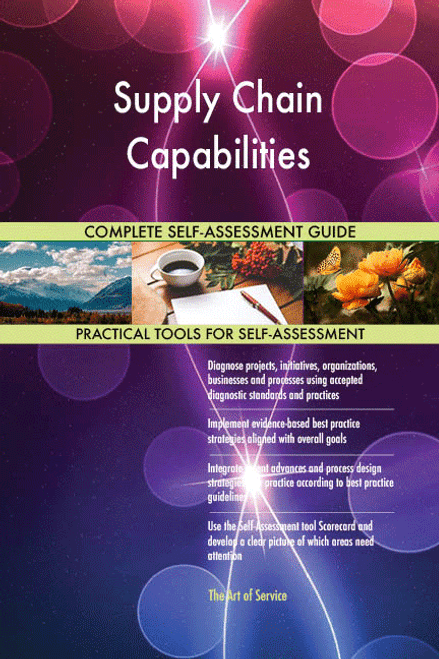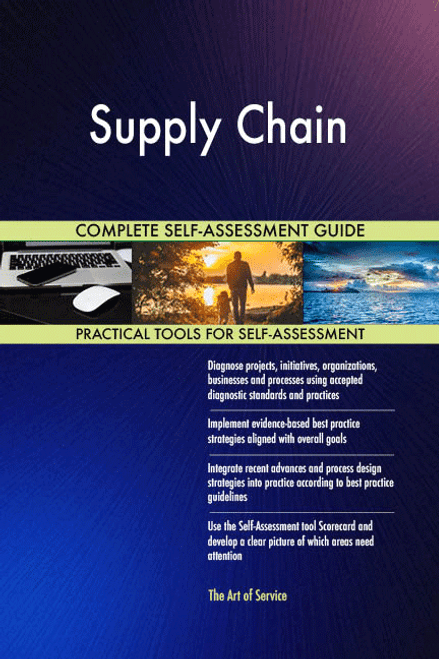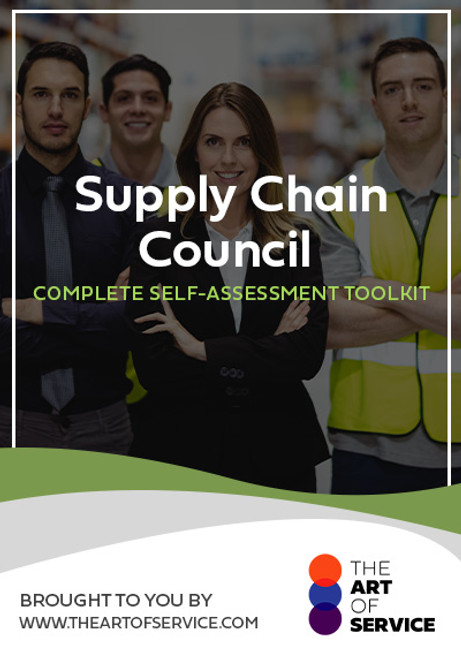Drive Supply Chain Capabilities: every system you install is designed for reliability, Network Security, and the flexibility needed to adapt to your evolving Business Needs.
More Uses of the Supply Chain Capabilities Toolkit:
- Identify and introduce new materials, Supply Chain Capabilities, technologies, and processes to meet current and future interests of products.
- Manage Planning System parameters and Master Data to optimally reflect Supply Chain Capabilities and plan supply.
- Provide the long term strategy and Implementation Plan of Key Technology solutions to support Supply Chain Capabilities.
- Supervise the small Enhancement queue for Supply Chain Planning applications, from inception to deployment.
- Follow Supply Chain department procedures to ensure the uninterrupted supply of raw materials and packaging components to support commercial production.
- Ensure your project maintains inventories by assessing material, supply and equipment needs, contacting vendors for bids, monitoring contractors, picking up parts from vendors or having parts delivered and ensuring proper orders are received.
- Oversee development and deployment of standard quality tools, methodologies, standards, practices and improvement processes through your manufacturing partners and Supply Chain.
- Provide input to the Supply Planning organization in creating a fulfillment plan and developing inventory strategies on existing items, new products, and product phase outs.
- Create a risk based process for the assessment and mitigation of any information Security Risk in your ecosystem consisting of Supply Chain partners, vendors, consumers and any other third parties.
- Solidify expertise applying data to solvE Business problems in Supply And Demand planning, inventory and distribution, Sales And Marketing, and finance.
- Identify, develop, lead and deliver the targeted financial results (Cost Reduction, savings and/or Working capital) from Supply Chain Improvement Initiatives.
- Confirm your venture ensures that Supply Chain processes are optimized across transportation, distribution, logistics, planning, forecasting, and customer solutions, and that Process Controls are in place.
- Develop and maintain valid End To End supply plans for each product group to promote and support execution for achieving customer Service Levels and inventory turns per agreed target levels.
- Ensure your organization coordinates material planning activity for material with long lead time as to eliminate any potential supply interruption and minimize inventory.
- Be certain that your design complies; analysts work cross functionality with sales, marketing, engineering, Supply Chain, and operations to help drive performance by aligning business actions with Customer Needs.
- Ensure your organization develops appropriate sources of supply and maintains cooperative working relationships with vendors to stay current with trends and technologies, products and services.
- Ensure you outperform; lead and manage Supply Chain Project Portfolio initiatives that drive improvements using Problem Solving, lean tools, metric development, and Visual Management.
- Ensure your venture leads a broad range of complex Supply Chain processes, as Inventory analysis and planning, Demand Planning, import/export operations, and sales and Operations Planning (SOP).
- Confirm your enterprise develops and implements comprehensive test strategies, test conditions, Test Plans, Test Cases/user stories, scripts, test steps, Test Data, and Test Automation.
- Maintain ongoing contact with sales staff, Supply Chain, manufacturing, and engineering to receive feedback regarding all aspects of workflow as shipment dates, special needs, product updates, feasible improvements, and problems.
- Confirm your organization ensures efficient Supply Chain and Inventory Optimization strategies; develops, implements and improves Internal Processes/controls to achieve Supply Chain objectives on an ongoing basis.
- Develop and build Analytical Tools to improve operational and Supply Chain efficiencies Excel, Power BI, ERP/MRP Reports, etc.
- Execute purchasing activities with an assigned supply base ensuring communication to suppliers is timely and accurate.
- Ensure you train; respond rapidly and flexibly to emerging issues in production, quality, engineering, or Supply Chain.
- Assure your operation complies; designs and implements Supply Chains that support Business Strategies adapted to changing market conditions, New Business Opportunities, or Cost Reduction strategies.
- Ensure inventory plans and execution of plans are consistent with Supply Chain goals.
- Methodize Supply Chain Capabilities: work closely with Product Leadership, design, and Development Teams to plan and launch projects on time, on budget and on spec.
- Be accountable for networking and collaboration with Supply Chain Operations team members as Inventory Management, Customer Service, warehouse leaders / employees, transportation and commercial excellence team members as Product Management, sourcing.
- Ensure you overhaul; build the retail warehouse Logistics And Supply Chain ecosystem partnerships with startups that provide disruptive Retail Solutions for Supply Chain and Distribution Centers.
- Oversee Supply Chain Capabilities: work collectively with the Supply Chain Management in facilitating information and inventory process updates to all field personnel.
- Lead Supply Chain Capabilities: innovative and independent thinker with a focus on Continuous Improvement and an entrepreneurial mentality.
- Assure your business leads development, testing, deployments, and iterative improvement of Product Capabilities and features in collaboration with designers, Product Managers, and other engineers on the product team.
- Ensure proactive engagement in Incident Management process, working with cross functional teams to minimize the impact of database outages.
Save time, empower your teams and effectively upgrade your processes with access to this practical Supply Chain Capabilities Toolkit and guide. Address common challenges with best-practice templates, step-by-step Work Plans and maturity diagnostics for any Supply Chain Capabilities related project.
Download the Toolkit and in Three Steps you will be guided from idea to implementation results.
The Toolkit contains the following practical and powerful enablers with new and updated Supply Chain Capabilities specific requirements:
STEP 1: Get your bearings
Start with...
- The latest quick edition of the Supply Chain Capabilities Self Assessment book in PDF containing 49 requirements to perform a quickscan, get an overview and share with stakeholders.
Organized in a Data Driven improvement cycle RDMAICS (Recognize, Define, Measure, Analyze, Improve, Control and Sustain), check the…
- Example pre-filled Self-Assessment Excel Dashboard to get familiar with results generation
Then find your goals...
STEP 2: Set concrete goals, tasks, dates and numbers you can track
Featuring 999 new and updated case-based questions, organized into seven core areas of Process Design, this Self-Assessment will help you identify areas in which Supply Chain Capabilities improvements can be made.
Examples; 10 of the 999 standard requirements:
- How is Supply Chain Capabilities data gathered?
- What qualifications are needed?
- If your customer were your grandmother, would you tell her to buy what you're selling?
- If you got fired and a new hire took your place, what would she do different?
- What do you need to qualify?
- What do you measure and why?
- What else needs to be measured?
- What have been your experiences in defining long range Supply Chain Capabilities goals?
- How does your organization define, manage, and improve its Supply Chain Capabilities processes?
- Who is responsible for Supply Chain Capabilities?
Complete the self assessment, on your own or with a team in a workshop setting. Use the workbook together with the self assessment requirements spreadsheet:
- The workbook is the latest in-depth complete edition of the Supply Chain Capabilities book in PDF containing 994 requirements, which criteria correspond to the criteria in...
Your Supply Chain Capabilities self-assessment dashboard which gives you your dynamically prioritized projects-ready tool and shows your organization exactly what to do next:
- The Self-Assessment Excel Dashboard; with the Supply Chain Capabilities Self-Assessment and Scorecard you will develop a clear picture of which Supply Chain Capabilities areas need attention, which requirements you should focus on and who will be responsible for them:
- Shows your organization instant insight in areas for improvement: Auto generates reports, radar chart for maturity assessment, insights per process and participant and bespoke, ready to use, RACI Matrix
- Gives you a professional Dashboard to guide and perform a thorough Supply Chain Capabilities Self-Assessment
- Is secure: Ensures offline Data Protection of your Self-Assessment results
- Dynamically prioritized projects-ready RACI Matrix shows your organization exactly what to do next:
STEP 3: Implement, Track, follow up and revise strategy
The outcomes of STEP 2, the self assessment, are the inputs for STEP 3; Start and manage Supply Chain Capabilities projects with the 62 implementation resources:
- 62 step-by-step Supply Chain Capabilities Project Management Form Templates covering over 1500 Supply Chain Capabilities project requirements and success criteria:
Examples; 10 of the check box criteria:
- Cost Management Plan: Eac -estimate at completion, what is the total job expected to cost?
- Activity Cost Estimates: In which phase of the Acquisition Process cycle does source qualifications reside?
- Project Scope Statement: Will all Supply Chain Capabilities project issues be unconditionally tracked through the Issue Resolution process?
- Closing Process Group: Did the Supply Chain Capabilities Project Team have enough people to execute the Supply Chain Capabilities Project Plan?
- Source Selection Criteria: What are the guidelines regarding award without considerations?
- Scope Management Plan: Are Corrective Actions taken when actual results are substantially different from detailed Supply Chain Capabilities Project Plan (variances)?
- Initiating Process Group: During which stage of Risk planning are risks prioritized based on probability and impact?
- Cost Management Plan: Is your organization certified as a supplier, wholesaler, regular dealer, or manufacturer of corresponding products/supplies?
- Procurement Audit: Was a formal review of tenders received undertaken?
- Activity Cost Estimates: What procedures are put in place regarding bidding and cost comparisons, if any?
Step-by-step and complete Supply Chain Capabilities Project Management Forms and Templates including check box criteria and templates.
1.0 Initiating Process Group:
- 1.1 Supply Chain Capabilities project Charter
- 1.2 Stakeholder Register
- 1.3 Stakeholder Analysis Matrix
2.0 Planning Process Group:
- 2.1 Supply Chain Capabilities Project Management Plan
- 2.2 Scope Management Plan
- 2.3 Requirements Management Plan
- 2.4 Requirements Documentation
- 2.5 Requirements Traceability Matrix
- 2.6 Supply Chain Capabilities Project Scope Statement
- 2.7 Assumption and Constraint Log
- 2.8 Work Breakdown Structure
- 2.9 WBS Dictionary
- 2.10 Schedule Management Plan
- 2.11 Activity List
- 2.12 Activity Attributes
- 2.13 Milestone List
- 2.14 Network Diagram
- 2.15 Activity Resource Requirements
- 2.16 Resource Breakdown Structure
- 2.17 Activity Duration Estimates
- 2.18 Duration Estimating Worksheet
- 2.19 Supply Chain Capabilities project Schedule
- 2.20 Cost Management Plan
- 2.21 Activity Cost Estimates
- 2.22 Cost Estimating Worksheet
- 2.23 Cost Baseline
- 2.24 Quality Management Plan
- 2.25 Quality Metrics
- 2.26 Process Improvement Plan
- 2.27 Responsibility Assignment Matrix
- 2.28 Roles and Responsibilities
- 2.29 Human Resource Management Plan
- 2.30 Communications Management Plan
- 2.31 Risk Management Plan
- 2.32 Risk Register
- 2.33 Probability and Impact Assessment
- 2.34 Probability and Impact Matrix
- 2.35 Risk Data Sheet
- 2.36 Procurement Management Plan
- 2.37 Source Selection Criteria
- 2.38 Stakeholder Management Plan
- 2.39 Change Management Plan
3.0 Executing Process Group:
- 3.1 Team Member Status Report
- 3.2 Change Request
- 3.3 Change Log
- 3.4 Decision Log
- 3.5 Quality Audit
- 3.6 Team Directory
- 3.7 Team Operating Agreement
- 3.8 Team Performance Assessment
- 3.9 Team Member Performance Assessment
- 3.10 Issue Log
4.0 Monitoring and Controlling Process Group:
- 4.1 Supply Chain Capabilities project Performance Report
- 4.2 Variance Analysis
- 4.3 Earned Value Status
- 4.4 Risk Audit
- 4.5 Contractor Status Report
- 4.6 Formal Acceptance
5.0 Closing Process Group:
- 5.1 Procurement Audit
- 5.2 Contract Close-Out
- 5.3 Supply Chain Capabilities project or Phase Close-Out
- 5.4 Lessons Learned
Results
With this Three Step process you will have all the tools you need for any Supply Chain Capabilities project with this in-depth Supply Chain Capabilities Toolkit.
In using the Toolkit you will be better able to:
- Diagnose Supply Chain Capabilities projects, initiatives, organizations, businesses and processes using accepted diagnostic standards and practices
- Implement evidence-based Best Practice strategies aligned with overall goals
- Integrate recent advances in Supply Chain Capabilities and put Process Design strategies into practice according to Best Practice guidelines
Defining, designing, creating, and implementing a process to solve a business challenge or meet a business objective is the most valuable role; In EVERY company, organization and department.
Unless you are talking a one-time, single-use project within a business, there should be a process. Whether that process is managed and implemented by humans, AI, or a combination of the two, it needs to be designed by someone with a complex enough perspective to ask the right questions. Someone capable of asking the right questions and step back and say, 'What are we really trying to accomplish here? And is there a different way to look at it?'
This Toolkit empowers people to do just that - whether their title is entrepreneur, manager, consultant, (Vice-)President, CxO etc... - they are the people who rule the future. They are the person who asks the right questions to make Supply Chain Capabilities investments work better.
This Supply Chain Capabilities All-Inclusive Toolkit enables You to be that person.
Includes lifetime updates
Every self assessment comes with Lifetime Updates and Lifetime Free Updated Books. Lifetime Updates is an industry-first feature which allows you to receive verified self assessment updates, ensuring you always have the most accurate information at your fingertips.







